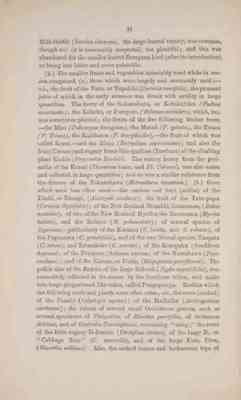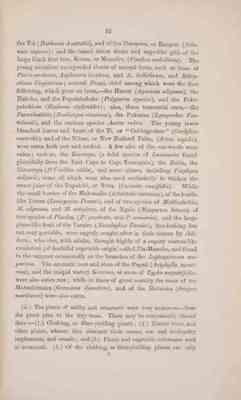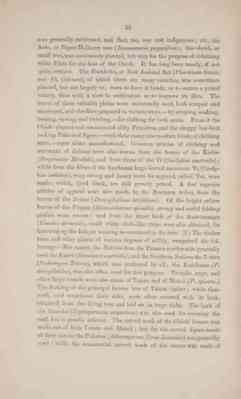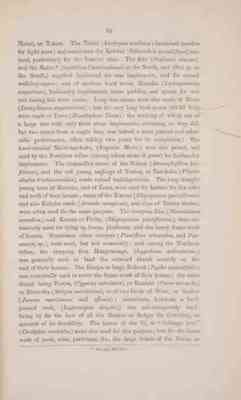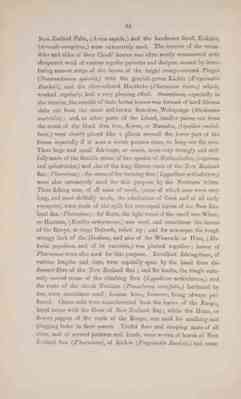Pages
31 Milk-thistle (Sonchus oleraceus), the large-leaved variety, was common. though not (it is reasonably suspected) too plentiful; and this was abandoned for the smaller leaved European kind (after its introduction) as being less bitter and more palatable.
(2.) The smaller fruits and vegetables invariably used while in season comprised, (a.) those which were largely and commonly used:- viz., the fruit of the Tutu, or Tupakihi (Coriaria ruscifolia), the pleasant juice of which in the early summer was drank with avidity in large quantities. The berry of the Kohutuhutu, or Kotukutuku (Fuchsia excorticata); the Kohoho, or Poroporo, (Solanum aviculare), which, too, was sometimes planted; the fruits of the five following timber trees, - the Miro (Podocarpus ferruginea), the Mataii (P. spicata), the Totara (P. Totara), - and Kahikatea (P. dacrydioides), - the fruit of which was called Koroi, - and the Rimy (Dacrydium cupressinum); and also the fruit (Ureure) and sugary bract-like spadices (Tawhara) of the climbing plant Kiekie (Freycinetia Banksii). The watery honey from the perianths of the Korari (Phormium tenax, and Ph. Colensoi), was also eaten and collected in large quantities; and so was a similar substance from the flowers of the Pohutukawa (Metrosideros tomentosa.) (b.) those which were less often used:- the curious red fruit (arillus) of the Titoki, or Titongi, (Alectryon excelsum): the fruit of the Tutu-papa (Coriaria thymifolia); of the New Zealand Bramble, Tataramoa, (Rubus australis); of two of the New Zealand Myrtles, the Ramarama (Myrtus bullata), and the Rohutu (M. pedunculata); of several species of Coprosma, - particularly of the Karamu (C. lucida, and C. robusta), of the Papaauma (C. grandifolia, and of the two littoral species, Taupata (C. retusa), and Tataraheke (C. acerosa); of the Koropuku (Gaultheria depressa); and of the Kareao, or Pirita, (Rhipogonum parviflorum). The pollen also of the flowers of the large Bulrush (Typha angustifolia), was extensively collected in its season by the Southern tribes, and made into large gingerbread like cakes, called Pungapunga. Besides which the following roots and plants were often eaten, viz., the roots (cooked) of the Panahi (Calystegia sepium); of the Maikaika (Arthropodium cirrhatum); the tubers of several small Orchideous genera, such as several specimens of Thelymitra, of Microtus porrifolia, of Orthoceras strictum, and of Gastrodia Cunninghamii, containing "salep;" the roots of the little sugary Ti-koraha (Cordyline stricta), of the large Ti, or "Cabbage Tree" (C. australis), and of the large Ferns, Para, (Marattia salicina). Also the cooked leaves and herbaceous tops of
32 the Toi (Barbarea Australis), and of the Poroporo, or Raupeti (Solanum nigrum); and the baked inner stems and sago-like pith of the large black fern tree, Korau, or Mamaku, (Cyathea medullaris). The young succulent unexpanded shoots of several ferns, such as those of Pteris esculenta, Asplenium lucidum, and A. bulbiferum, and Botrychium Virginicum; several Fungi, chief among which were the four following, which grow on trees, - the Harori (Agaricus adiposus), the Hakeke, and the Popoiahakeke (Polyporus species), and the Pekepekekiore (Hydnum clathroides); also, three terrestrial ones, - the Paruwhatitiri (Ileodictyon cibarium), the Pukurau (Lycoperdon Fontainesii), and the curious species Aseroe rubra. The young inner blanched leaves and heart of the Ti, or "Cabbage-tree" (Cordyline australis), and of the Nikau, or New Zealand Palm, (Areca sapida), were eaten both raw and cooked. A few also of the sea-weeds were eaten; such as, the Karengo, ( a tidal species of Laminaria found plentifully from the East Cape to Cape Turnagain), the Rehia, the Rimurapa (D'Urvillea utilis), and some others, including Porphyra vulgaris; some of which were also used exclusively to thicken the sweet juice of the Tupakihi, or Tutu, (Coriaria ruscifolia). While the small berries of the Makomako (Aristotelia racemosa), of the heathlike Totara (Leucopogon Fraseri), and of two species of Muhlenbeckia, M. adpressa, and M. complexa, of the Ngaio (Myoporum laetum), of two species of Pimelea, (P. prostrata, and P. arenaria), and the large plum-like fruit of the Taraire (Nesodaphne Taraire), fine-looking but not very gustable, were eagerly sought after in their season by children; who also, with adults, thought highly of a sugary manna-like exudation (of doubtful vegetable origin) called Pia-Manuka, and found in the summer occsionally on the branches of the Leptospermum scoparium. The aromatic root and stem of the Papaii (Aciphylla squarrosa), and the insipid watery Koreirei, or roots of Typha angustifolia, were also eaten raw; while in times of great scarcity the roots of the Matuakumara (Geranium dissectum), and the Ririwaka (Scirpus maritimus) were also eaten.
(ii.) The plants of utility and ornament were very numerous - from the giant pine to the tiny moss. These may be conveniently classed thus:- (1.) Clothing, or fibre-yielding plants; (2.) Timber trees, and other plants, whence they obtained their canoes, war and husbandry implements, and vessels; and (3.) Plants and vegetable substances used as ornament. (1.) Of the clothing, or fibre-yeielding plants, one only F
33 was generally cultivated, and that, too, was not indigenous; viz., the Aute, or Paper-Mulberry tree (Broussonetia papyrifera); this shrub, or small tree, was assiduously planted, but only for the purpose of obtaining whte fillets for the hair of the Chiefs, It has long been nearly, if not quite, extinct. The Harakeke, or New Zealand flax (Phormium tenax, and Ph. Colensoi), of which there are many varieties, was sometimes planted, but not largely so; more to have it handy, or to secure a prized variety, than with a view to cultivation or to improve its fibre. The leaves of these valuable plants were universally used, both scraped and unscraped, and the fibre prepared in various ways, - by scraping, soaking, beating, dying, and twisting, - for clothing for both sexes. From it the Chief's elegant and ornamented silky Paipairoa, and the shaggy bee-butt looking Pake and Ngeri, - with their many intermediate kinds of clothing mats, - were alone manufactured. Common articles of clothing and war-mats of defence were also woven from the leaves of the Kiekie (Freycinetia Banksii), and from those of the Ti (Cordyline australis); while from the fibres of the handsome large-leaved mountain Ti, (Cordyline indivisa), very strong and heavy mats for apparel, called Toi, were made; which, dyed black, are still greatly prized. A few superior articles of apparel were also made, by the Northern tribes, from the leaves of the Neinei (Dracophyllum latifolium). Of the bright yellow leaves of the Pingao (Desmoschoenus spiralis), strong and useful folding girdles were woven; and from the inner bark of the Aute-taranga (Pimelea arenaria), small white cloth-like strips were also obtained, for fastening up the hair, or wearing as ornament in the ears. (2.) The timber trees and other plants of various degrees of utility, comprised the following:- For canoes, the Natives from the Thames northwards generally used the Karui (Dammara australis), and the Southern Natives the Totara (Podocarpus Totara), which was prefereed by all; the Kahikatea (P. dacrydioides), was also often used for this purpose. Troughs, trays, and other large vessels were also made of Totara and of Mataii (P. spicata.) The framing of the principal houses was of Totara timber; while their roofs, and sometimes their sides, were often covered with its bark, obtained from the living tree and laid on in large slabs. The bark of the Manuka (Leptospermum scoparium) was also used for covering the roof, but is greatly inferior. The carved work of the Chief's houses was made out of both Totara and Mataii; but for the carved figure-heads of their canoes the Pukatea (Atherosperma Novae-Zelediae) was generally used; while the ornamental carved work of the sterns was made of
34 Mataii, or Totara. The Titoki (Alectryon excelsum) furnished handles for light axes; and sometimes the Kowhai (Edwardsia grandiflora) was used, particularly for the heavier ones. The Ake (Dodonaea viscosa), and the Maire,* (Santalm Cunninghamii at the North, and Olea sp. at the South,) supplied hardwood for war implements, and for carved walking-staves; and of another hard wood, Manuka (Leptospermum scoparium), husbandry implements, canoe paddles, and spears for war and taking fish were made. Long war-spears were also made of Rimu (Dacrydinum cupressinum); but the very long bird-spears (30-36 feet) were made of Tawa (Nesodaphne Tawwa): the working of which out of a large tree with only their stone implements, obtaining, as they did, but two spears from a single tree, was indeed a most patient and admirable performance, often taking two years for its completion! The hard-wooded Maire-Tawhake, (Eugeenia Maire,) was also prized, and used by the Northern tribes (among whom alone it grew) for husbandry implements. The channelled stems of the Neinei (Dracophyllum latifolium), and the red young saplings ot Toatoa, or Tanekaha (Phyllocladus trichomanoides), made valued walking-sticks. The long straight young trees of Manuka, and of Tawa, were used for battens for the sides and roofs of their houses; stems of the Kareao (Rhipogonum parviflorum) and also Kakaho reeds (Arundo conspicua), and slips of Totara timber, were often used for the same purpose. The creepers, Aka, (Metrosideros scandens,) and Kareao or Pirita, (Rhipogonum parviflorum,) were extensively used for tying up fences, platforms, and the heavy frame-work of houses. Sometimes other creepers (Passiflora tetrandra, and Parsonsia, sp.), were used, but not commonly; and, among the Northern tribes, the creeping fern Mangemange, (Lygodium articulatum,) was generally used to bind the outward thatch securely on the roof of their houses. The Raupo, or large Bulrush (Typha angustifolia) was universally used to cover the frame-work of their houses; the outer thatch being Toetoe, (Cperus ustulatus), or Tautahi (Carx ternaria,) or Ririwaka (Scirpus maritimus), or of two kinds of Wiwi, or Rushes (Juncus maritimus, and effusus); sometimes, however, a hardjointed rush, (Leptocarpus simplex,) was advantageously used; being by far the best of all the Rushes or Sedges for thatching, on account of its durability. The leaves of the Ti, or "Cabbage tree," (Cordyline australis,) were also used for this purpose; but, for the inner work of roofs, sides, partitions, &c., the large fronds of the Nikau, or ____________________________________________________________ * See par.26 (viii.)
35 New Zealand Palm, (Areca sapida,) and the handsome Reed, Kakaho, (Arundo conspicua,) were extensively used. The interior of the verandahs and sides of their Chiefs' houses was often neatly ornamented with chequered work of various regular patterns and designs, caused by interlacing narrow strips of the leaves of the bright orange-coloured Pingae (Desmoschoenus spiralis,) with the greyish-green Kiekie (Freycinetia Banksii), and the olive-colored Harakeke (Phormium tenax,) which, worked regularly, had a very pleasing effect. Sometimes, especially in the interior, the outside of their better houses was formed of hard fibrous slabs cut from the stout red-brown fern-tree, Wekiponga (Dicksonia australis); and, in other parts of the Island, smaller pieces cut from the trunk of the black fern tree, Korau, or Mamaku, (Cyathea medullaris,) were closely placed like a plinth around the lower part of the house, especially if it were a sweet potatoe store, to keep out the rats. Their large and small fish-traps, or creels, were very strongly and skilfully made of the flexible stems of two species of Muhlenbeckia, (adpressa and ephedroides,) and also of the long fibrous roots of the New Zealand flax (Phormium); for floats, the light wood of the small tree Whau, or Hauama, (Entelea arborescens,) was used, and sometimes the leaves of the Raupo, or large Bulrush, rolled up; and for net-ropes the tough stringy bark of the Houhere, and also of the Whauwhi or Houi, (Hoheria populnea, and of its varieties,) was plaited together; leaves of Phormium were also used for this purpose. Excellent fishing-lines, of various lengths and sizes, were capitally spun by the hand from the dressed fibre of the New Zealand flax; and for hooks, the tough naturally curved stems of the climbing fern (Lygodium articulatum,) and the roots of the shrub Tauhinu (Pomaderris ericifolia,) hardened by fire, were sometimes used; human bone, however, being always preferred. Canoe sails were manufactured from the leaves of the Raupo, laced across with the fibres of New Zealand flax; while the Hune, or downy pappus of the seeds of the Raupo, was used for caulking and plugging holes in their canoes. Useful floor and sleeping mats of all sizes, and of several patterns and kinds, were woven of leaves of New Zealand flax (Phormium), of Kiekie (Freycinetia Banksii,) and some-
